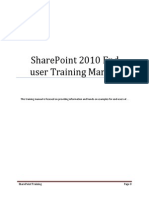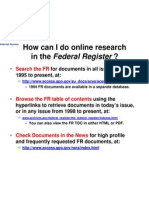1.1.2.3 Programming - Absolute Basics PDF
Uploaded by
eka russanty1.1.2.3 Programming - Absolute Basics PDF
Uploaded by
eka russanty6/28/2019 1.1.2.
3 Programming - absolute basics
Sandbox (/sandbox)
What makes a language?
We can say that each language (machine or natural, it doesn't matter) consists of the following
elements:
AN ALPHABET
a set of symbols used to build words of a certain language (e.g., the Latin alphabet for English,
the Cyrillic alphabet for Russian, Kanji for Japanese, and so on)
A LEXIS
(aka a dictionary) a set of words the language o ers its users (e.g., the word "computer"
comes from the English language dictionary, while "cmoptrue" doesn't; the word "chat" is
present both in English and French dictionaries, but their meanings are di erent)
A SYNTAX
a set of rules (formal or informal, written or felt intuitively) used to determine if a certain
string of words forms a valid sentence (e.g., "I am a python" is a syntactically correct phrase,
while "I a python am" isn't)
SEMANTICS
a set of rules determining if a certain phrase makes sense (e.g., "I ate a doughnut" makes
sense, but "A doughnut ate me" doesn't)
The IL is, in fact, the alphabet of a machine language. This is the simplest and most primary
set of symbols we can use to give commands to a computer. It's the computer's mother
tongue.
Unfortunately, this tongue is a far cry from a human mother tongue. We all (both computers
and humans) need something else, a common language for computers and humans, or a
bridge between the two di erent worlds.
We need a language in which humans can write their programs and a language that
computers may use to execute the programs, one that is far more complex than machine
language and yet far simpler than natural language.
Such languages are often called high-level programming languages. They are at least
somewhat similar to natural ones in that they use symbols, words and conventions readable
to humans. These languages enable humans to express commands to computers that are
much more complex than those o ered by ILs
Prev (/learn/programming-essentials-in-python/programming-absolute-basics-1)
https://edube.org/learn/programming-essentials-in-python/programming-absolute-basics-2 1/1
You might also like
- Programming Essentials in Python: Module 1No ratings yetProgramming Essentials in Python: Module 145 pages
- Genki - An Integrated Course in Elementary Japanese Workbook II (Second Edition) (2011), WITH PDF BOOKMARKS!85% (27)Genki - An Integrated Course in Elementary Japanese Workbook II (Second Edition) (2011), WITH PDF BOOKMARKS!130 pages
- Sandbox (/sandbox) : MODULE (8%) SECTION (14%)No ratings yetSandbox (/sandbox) : MODULE (8%) SECTION (14%)13 pages
- 0.1 Programming Absolute Basics 0.1.1 How Does A Computer Program Work?No ratings yet0.1 Programming Absolute Basics 0.1.1 How Does A Computer Program Work?29 pages
- Cisco Python: Welcome To Programming Essentials in Python - Part 1100% (2)Cisco Python: Welcome To Programming Essentials in Python - Part 131 pages
- How Does A Computer Program Work?: Language Is The KeywordNo ratings yetHow Does A Computer Program Work?: Language Is The Keyword10 pages
- Module 1 - Introduction to Python and Computer ProgrammingNo ratings yetModule 1 - Introduction to Python and Computer Programming11 pages
- CEN111: Programming I: International Burch UniversityNo ratings yetCEN111: Programming I: International Burch University7 pages
- What Makes A Language?: Certified Entry-Level Python Programmer (PCEP-30-02)No ratings yetWhat Makes A Language?: Certified Entry-Level Python Programmer (PCEP-30-02)26 pages
- Computer Languages, Algorithms and Program Development: How Do Computers Know What We Want Them To Do?No ratings yetComputer Languages, Algorithms and Program Development: How Do Computers Know What We Want Them To Do?40 pages
- Cseb114: Principle of Programming: Chapter 1: Introduction To Computer and ProgrammingNo ratings yetCseb114: Principle of Programming: Chapter 1: Introduction To Computer and Programming29 pages
- Python Programming: An Introduction To Computer Science: Computers and ProgramsNo ratings yetPython Programming: An Introduction To Computer Science: Computers and Programs46 pages
- Week 02 - Introduction To LAB and Programming ConceptsNo ratings yetWeek 02 - Introduction To LAB and Programming Concepts37 pages
- Computer Programs: The Act of Designing and Implementing Computer Programs Is Called ProgrammingNo ratings yetComputer Programs: The Act of Designing and Implementing Computer Programs Is Called Programming1 page
- New Learning of Python by Practical Innovation and TechnologyFrom EverandNew Learning of Python by Practical Innovation and TechnologyNo ratings yet
- 1.1.2.4 Programming - Absolute Basics - Compilation vs. InterpretationNo ratings yet1.1.2.4 Programming - Absolute Basics - Compilation vs. Interpretation1 page
- SharePoint 2010 End-User Training ManualNo ratings yetSharePoint 2010 End-User Training Manual28 pages
- Best of Both Worlds - Combine KG and Vector Search For Enhanced RAG - Neo4jNo ratings yetBest of Both Worlds - Combine KG and Vector Search For Enhanced RAG - Neo4j40 pages
- Learn PowerShell Scripting in a Month of Lunches: Write and organize scripts and tools, 2nd Edition James Petty 2024 Scribd Download100% (1)Learn PowerShell Scripting in a Month of Lunches: Write and organize scripts and tools, 2nd Edition James Petty 2024 Scribd Download41 pages
- Full download (Ebook) Accounting Information Systems by Ulric J. Gelinas, Richard B. Dull, Patrick Wheeler, Mary Callahan Hill ISBN 9781337552127, 1337552127 pdf docx100% (11)Full download (Ebook) Accounting Information Systems by Ulric J. Gelinas, Richard B. Dull, Patrick Wheeler, Mary Callahan Hill ISBN 9781337552127, 1337552127 pdf docx65 pages
- Manisha - Smart Phones Vs DSLR - Final - 2020No ratings yetManisha - Smart Phones Vs DSLR - Final - 202034 pages





























































































